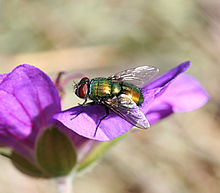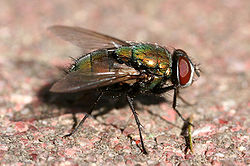- Common green bottle fly
-
Common green bottle fly 
Scientific classification Kingdom: Animalia Phylum: Arthropoda Class: Insecta Order: Diptera Family: Calliphoridae Genus: Lucilia Species: L. sericata Binomial name Lucilia sericata
(Meigen, 1826)Synonyms The common green bottle fly (Lucilia sericata) is a common blow-fly found in most areas of the world, and the most well-known of the numerous green bottle fly species. It is 10–14 mm long, slightly larger than a housefly, and has brilliant, metallic, blue-green or golden coloration with black markings. It has black bristle-like hair and three cross-grooves on the thorax. The wings are clear with light brown veins, and the legs and antennae are black. The maggots (larvae) of the fly are used for maggot therapy.
Contents
Distribution and behavior
L. sericata is common all over the world, mainly the southern hemisphere, dominating in Africa and Australia. It is coastal in its distribution and prefers warm and moist climates.[2] The female will lay her eggs in meat, fish, animal corpses, infected wounds of humans or animals, and excrement. The larvae of this insect feed on most decomposing tissue, but seem to concentrate on the Ovis genus which cause many problems for sheep farmers. This insect is also typical to most fly species by having three instar stages, a pre-pupa stage, and a pupa stage.
Morphology
The defining characteristic of L. sericata, and most used when identifying the adult fly is the presence of three bristles on the dorsal mesothorax. This body region is located on the middle of the back of the fly. L. sericata is almost identical to its sister species, Lucilia cuprina. Identification between these requires microscopic examination of two main distinguishing characteristics. As opposed to L. cuprina which has a metallic green femoral joint in the first pair of legs, L. sericata is blue-black. Also, when looking at the occipital setae, L. sericata has 6–8 bristles on each side while L. cuprina have only one. [3]
Life cycle
L. sericata begin their life cycle by laying a mass of eggs in a wounded area, a carcass or corpse, or in necrotic or decaying tissue. The eggs will hatch out in anywhere from 8–10 hours in warm moist weather to three days in cooler weather. L. sericata can have a lifetime reproductive output of 130 to 172 eggs The pale yellow or grayish conical larvae, like that of most blowflies, have two posterior spiracles through which respiration occurs.These larvae are moderately sized ranging from 10 to 14 millimeters long.
The larva feeds on the dead or necrotic tissue anywhere from 3 to 10 days, again, depending on the temperature. During these 4 to 8 days the larva passes through 3 larval instars. The larval instars will develop according to the temperature in their environment. The cooler the temperature (16˚C) the first larva instar will take about 53 hours, the second instar will take about 42 hours and the third instar will take about 98 hours to complete that portion of their life cycle. At warmer temperatures (27˚C) the first larva instar will take about 31 hours, the second instar will take about 12 hours, and the third instar will take about 40 hours to complete that specific stage of the life cycle. [4] The third instar larva will then drop off of the host onto soil where it will pupate for 6 to 14 days. However, if the temperature is relatively cold, the pupa can also overwinter in the soil until the soil temperature warms again. After the pupa transforms, the adult will emerge from the soil and also feed on dead or necrotic tissue. Adults usually lay eggs about 2 weeks after they emerge. Their total life cycle ranges from 2 to 3 weeks, but again can be shortened during the summer when they are most active, or lengthened in cooler seasons. L. sericata usually completes 3 or 4 generations each year.[5]
Forensic importance
L. sericata is an important species to forensic entomologists. Like most Calliphorids, the insect has been heavily studied and its life cycle and habits are well documented. Due to this, the stage of the insect’s development on a corpse is used to calculate a minimum period of colonization, so that it can used to aid in determining the time of death of the victim. The presence or absence of L. sericata can show a lot about the conditions of the corpse. If the insects seem to be on the path of their normal development, it is likely that the corpse has been undisturbed. If however, the insect shows signs of a disturbed life cycle, or if it is absent from a decaying body, this can show signs of post-mortem tampering with the body. Because L. sericata is one of the first insects to colonize a corpse, it is preferred over many other species in determining an approximate time of colonization. Developmental progress is determined with relative accuracy by measuring the length and weight of larval life cycles.[6]
Veterinary importance
Many blowflies have an impact in the veterinary sense, and L. sericata is no exception. In places like the UK and Australia L. sericata is commonly referred to as the "sheep blowfly" since sheep are its primary host. Although it affects mainly sheep, L. sericata is not host-specific.
In northern Europe, the fly will lay its eggs in sheep wool. The larvae will then migrate down the wool where it will feed directly on the skin surface. This can cause massive lesions and secondary bacterial infections. In the UK, it is estimated that blowfly strike affects 1 million sheep as well as 80% of sheep farms each year. This causes a huge economic impact in these regions. Not only does it cost money to treat infected animals, but also, measures must be taken to control L. sericata.
Since this fly tends to lay its eggs in wool, a simple and effective way to reduce the incidence of infection is to shear ewes regularly. Enacting simple sanitary measures can also reduce blowfly strike. Timely and proper disposal of carcasses and proper removal of feces can aid in significantly reducing strike. Moving sheep from warm, humid, and sheltered areas to more open areas can also help to reduce blowfly strike, for this eliminates conditions conducive to fly development. Trapping systems such as sticky paper may also be used to control fly numbers. Treating a flock with chemical agents can be costly but can aid greatly in maintaining the resistance of the flock to L. sericata. Plunge dipping in diazinon can directly kill the fly on contact. This method works from 3 to 8 weeks in controlling the fly. An alternate chemical method is a pyrethroid pour-on, which will last from 6 to 10 weeks depending on the exact type of pyrethroid used. Cryomazine and dicylanil, which are insect growth regulators, are also effective and last from 10 to 16 weeks. Although chemical treatment can be very effective, it is costly, tedious, and takes up valuable time. [7]
Medical importance
L. sericata has been of medical importance since 1826, when Meigen removed larvae from the eyes and facial cavities of a human patient. L. sericata has shown promise in three separate clinical approaches. First, larvae have been shown to debride wounds with extremely low probability of myiasis upon clinical application. Larval secretions have been shown to help in tissue regeneration. L. sericata have also been shown to lower bacteremia levels in patients infected with MRSA. Basically, L. sericata larvae can be used as biosurgery agents in cases where antibiotics and surgery are impractical.
Studies have shown that larval secretions in vitro have been successful in enhancing fibroblast migration to wound site, positively impacting wound closure. [8] It is found that larval therapy of L. sericata is highly recommended for the treatment of wounds infected with Gram-positive bacteria, yet is not as effective for wounds that are infected with Gram-negative bacteria. Also, studies shown that bacteria from the genus Vagococcus were resistant to the maggot excreta/secreta. [9] Attempts are currently undergoing to extract or synthesize the chymotrypsins found in larval secretions to destroy MRSA without application of the larva itself.[10]
Continuing research
Due to this species' high forensic interest, extensive research on its life cycle has already been conducted. Medically, however, research is ongoing centered on the secretions produced by L. sericata as an agent against MRSA and VRSA[11] , and the larval applications for maggot therapy. Efforts in the latter are geared toward making medical professionals more familiar to the current techniques. [12] Like many other ectoparasites, L. sericata has a huge economic impact on farmers. Due to this, many studies and research projects have been put in place since the late 1980’s to help farmers reduce the impact of L. sericata.
References
- ^ a b c Chandler, Peter J. (1998). "Checklists of Insects of the British Isles (New Series) Part 1: Diptera". Handbooks for the Identification of British Insects. 2 (London: Royal Entomological Society of London) 12 (1): 1–234.
- ^ [1] Australian Museum: Decompostition: Corpse fauna page
- ^ Bishop, Dallas. Variations in numbers of occipital setae for two species of Lucilia (Diptera: Calliphoridae) in New Zealand. New Zealand Entomologist. 1991. Vol 14. 29-31. [2]
- ^ [3] Australian Museum: Development times of Lucilia sericata at different temperatures: Corpse fauna page
- ^ Cetinkaya, Merih et al. Turkish Journal of Pediatrics."Neonatal myiasis: a case report. 50.581-584. 2008.
- ^ *Tarone AM, Foran DR. U.S. National Library of Medicine. Pub-Med. Generalized additive models and Lucilia sericata growth: assessing confidence intervals and error rates in forensic entomology. July 2008.
- ^ Sargison, Neil. “The Management of Ectoparasitic Diseases of UK Sheep”. World Veterinary Congress. Royal (Dick) School of Veterinary Studies, Easter Bush Veterinary Center, Roslin, Midlothian, Scotland. 27-31 July 2008.
- ^ Horobin et al. Maggots & Wound healing: The Effects of Lucilia sericata Larval Secretions upon Human Dermal Fibroblasts. European Cells and Materials. Vol. 6 Suppl 2, 2003 (3)
- ^ Jaklic, Domen. Journal of Medical Microbiology. “Selective antimicrobial activity of maggots against pathogenic bacteria”. 57. 617-625. (2008)
- ^ [4] Chymotrypsin From Lucilia sericata Larvae and its Use for the Treatment of Wounds
- ^ Cazander, G et al. Journal of Tissue Viability."Do maggots have an ifluence on bacterial growth? A study on the susceptibility of strains of six different bacterial species to maggots of Lucilia sericata and their excretions/secretions 2009.
- ^ Jones, Gemma & Wall, Richard. Research in Veterinary Science. Maggot-therapy in veterinary medicine. 85. 394-398. 2008.
External links
- [5] Closeup photographs of Lucilia sericata
- Maggot Therapy Project web site at the University of California, Irvine, list of maggot therapy practitioners
- Green Bottle Maggots help cure MRSA patients
- Monaghan, Peter Rx:Maggots, Notes from Academe, The Chronicle of Higher Education, June 1, 2007 (Vol. LIII, No. 39), p. A48.
- Lucilia sericata on the UF / IFAS Featured Creatures Web site
Categories:- Calliphoridae
- Pollinators
- Animals described in 1826
Wikimedia Foundation. 2010.

